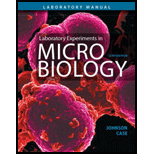
Pearson eText for Laboratory Experiments in Microbiology -- Instant Access (Pearson+)
12th Edition
ISBN: 9780137546503
Author: Ted Johnson, Christine Case
Publisher: PEARSON+
expand_more
expand_more
format_list_bulleted
Textbook Question
Chapter 14, Problem 3Q
Which of these media is selective? ______________Why is it selective?
Expert Solution & Answer
Want to see the full answer?
Check out a sample textbook solution
Students have asked these similar questions
ethical considerations in medical imaging
Please correct answer and don't used hand raiting and don't used Ai solution
2. In one of the reactions of the citric acid cycle, malate is oxidized to oxaloacetate. When this
reaction is considered in isolation, a small amount of malate remains and is not oxidized.
The best term to explain this is
a. enthalpy
b. entropy
c. equilibrium
d. free energy
e. loss of energy
Chapter 14 Solutions
Pearson eText for Laboratory Experiments in Microbiology -- Instant Access (Pearson+)
Ch. 14 - Why are fermentation tubes evaluated at 24 and 48...Ch. 14 - If an organism metabolizes glucose aerobically,...Ch. 14 - Which of these media is selective?...Ch. 14 - Could an organism be a fermenter and also be both...Ch. 14 - How could you determine which of the following...Ch. 14 - If a bacterium cannot ferment glucose, why not...Ch. 14 - If a bacterium cannot use glucose, what result...Ch. 14 - If a bacterium cannot use citrate, what result...Ch. 14 - You put an opened bottle of orange drink in the...
Knowledge Booster
Learn more about
Need a deep-dive on the concept behind this application? Look no further. Learn more about this topic, biology and related others by exploring similar questions and additional content below.Similar questions
- 18. The citric acid cycle takes place in a. the chloroplasts b. the cytosol c. the inner mitochondrial membrane d. between the two mitochondrial membranes e. the mitochondrial matrix 40 WILarrow_forward8. Most reactions of anaerobic respiration are similar to a. aerobic respiration b. photosynthesis c. lactic acid fermentation d. alcoholic fermentation e. both c and darrow_forward12. Which of the following molecules can absorb light? a. Pigments b. Chlorophyll c. Rhodopsin d. Carotenoids e. All of the abovearrow_forward
- Which of the following proteins or protein complexes is directly required for the targeting of mitochondrial inner membrane multipass proteins, such as metabolite transporters, whose signal sequence is normally not cleaved after import? OA. TIM22 OB. TIM23 C. OXA OD. Mia40 OE SAMarrow_forwardQUESTION 9 An animal cell has been wounded and has a small rupture in its plasma membrane. Which of the following is more likely to happen next? OA. The cell rapidly cleaves by cytokinesis. OB. The rate of receptor-mediati endocytosis is increased. OC. The rate of exocytosis is increased. OD. The rate of pinocytosis is increased.arrow_forwardFor the a subunit of a trimeric G protein, A. a G-protein-coupled receptor GPCR) acts as a guanine nucleotide exchange factor (GEF), whereas a regulator of G protein signaling (RGS) can act as a GTPase-activating protein (GAP). B. a GPCR acts as a GAP, whereas an RGS can act as a GEF. C. both a GPCR and an RGS can act as a GEF. O D. both a GPCR and an RGS can act as a GAP OE. None of the above.arrow_forward
- A cell expresses a transmembrane protein that is cleaved at the plasma membrane to release an extracellular fragment. The fragment binds to receptor proteins on nearby cells and activates signaling pathways resulting in altered gene expression patterns in the cells. What form of intercellular signaling does this represent? OA. Contact-dependent signaling B. Paracrine signaling OC. Synaptic signaling D. Endocrine signaling E. Autocrine signalingarrow_forwardWhich of the following drive nuclearly encoded proteins import into the mitochondrial matrix? OA. ATP hydrolysis OB. Membrane Potential OC. K+ Ions OD. A and B OE. None of the abovearrow_forwardWhich of the following statements is true regarding Cholesterol import into the cell? OA. It is transported within LDL B. Receptor mediated endocytosis is involved OC. Release of cholesterol occurs in the Lysosome D. All of the above are true statements OE. None of the above are true statementsarrow_forward
- In which of the following schematic drawings of signaling pathways does the activation of the receptor lead to gene expression? Activating and inhibitory steps are indicated with (+) and (-), respectively. OA OB ㅇㅂㅇㅂㅇㅁ (+) Gene Expression Activated Signaling proteins Transcription receptor activator Bl D Gene Expression Gene Expression ㅁㅁㅇ Gene Expression Gene Expressionarrow_forwardWhich of the following events normally activates a GTP-binding protein? OA. GTP hydrolysis by the protein OB. Activation of an upstream GTPase-activating protein OC. Activation of an upstream guanine nucleotide exchange factor OD. Phosphorylation of a bound GDP molecule by an upstream phosphorylase OE. Pi release after GTP hydrolysisarrow_forwardProteins that are synthesized on the Rough ER are imported into the ER lumen after their signal sequence is recognized. Which of the following is responsible for the signal recognition? OA. Signal Recognition Particle, OB. Signal Sequence C. Stop-transfer sequence OD. Both B and C OE. None of the abovearrow_forward
arrow_back_ios
SEE MORE QUESTIONS
arrow_forward_ios
Recommended textbooks for you
 Nutrition Through The Life CycleHealth & NutritionISBN:9781337919333Author:Brown, Judith E.Publisher:Cengage Learning,
Nutrition Through The Life CycleHealth & NutritionISBN:9781337919333Author:Brown, Judith E.Publisher:Cengage Learning,



Nutrition Through The Life Cycle
Health & Nutrition
ISBN:9781337919333
Author:Brown, Judith E.
Publisher:Cengage Learning,



Biochemical Tests-Part 1; Author: Southern Stacker;https://www.youtube.com/watch?v=a-i9vANfQWQ;License: Standard Youtube License